Parts of a Saddle: Western and English Saddles
Parts of a saddle consist of a fork, the cantle, horn, skirt, seat, gullet, flaps, and knee pads. If you are a beginner horse rider, it must be very overwhelming to know each part in detail. However, it is not an impossible task. You can learn about each piece once you start tacking up a horse. Before going into detail about each part of a saddle, it is essential to know the two famous horse-riding disciplines; English and Western horse riding.
Parts of a Saddle: Difference between an English and a Western Riding Style
English riding can be dated back to medieval times. The primary purpose of English riding, at that time, was public appearance. Therefore, the English saddles were designed accordingly. However, as demand increased, further modifications were made to English saddles to fulfill the requirement with time.
Western discipline was more concerned with the usage of horses for herding or cattle purposes. The idea was to keep the rider comfortable for a long and rough journey on rugged terrain. This is when the term “cowboy” was introduced.
Now, both English and Western horse-riding styles have evolved. There are numerous ways in which each riding discipline is used, whether in sports, work, or leisure trails.
Difference between an English and a Western Saddle
Another essential difference between the two styles is the saddle and its accessories. As the primary objective of each style varies, the shape and style of the harness are also modified. Western saddles are usually big, have flat bottoms, soft-lining underneath the seat, and have a handle or horns in the front. They are also decorated with different ornaments and leatherwork.
Whereas English saddles are simple and small in size. They only cover the area where the rider is supposed to be seated. English saddles are not quite often embellished with artwork or ornaments.
Now that we have a general idea of both riding styles let us go into detail about the saddle parts. The main structure is made up of wood and is known as a tree. The tree determines the size of the saddle. As English saddles are small and lightweight compared to Western saddles, the dimension of a tree also varies. This saddle part is not visible to all as it will be entirely covered with leather.
- The Gullet
- The Horn
- The Fork
- Seat
- The Cantle
- The Skirt
- Cinch
- Flaps & Billets
The Gullet:
The gullet is the tunnel created when the saddle bars’ fit the horses’ withers. It lies underneath the saddle and is one of the most crucial parts determining a perfect tackle. If the angle created by the saddle bars is too wide or too narrow, it will discomfort the horse during the ride. Therefore, checking and measuring the gullet height is vital before ordering a new saddle.
The Horn:
The horn is the most recognized part of a Western saddle. It is located on the top of a Swell or a Fork. The horn is used to tie one end of the rope belonging to the horse. Sometimes, it also provides support for the rider to get on and off the horse but is not generally recommended.
The Fork:
The Fork is also known as Pommel. In English discipline, it is known as Pommel, whereas in Western-style, it is commonly referred to as Fork or Swells. So, the Fork is the front part of a saddle. It is curved slightly upwards, providing a supporting position for the rider in the seat. And, should clear the horses’ withers, the highest part of the horses’ back. It also includes the knee pads or flaps, the part where the rider rests his knees.
Seat:
The seat is the place where the rider sits. It is located on top of the tree. The center is cushioned with leather and other foaming materials to provide comfort while riding. The seat is available in different styles and sizes, depending on the needs of the rider. The most comfortable chair is gently curved and padded with soft materials to provide a good balance and support for the rider. However, flat and hard seats are also available for riding purposes.
The Cantle:
The cantle is the part of a saddle that provides back support for the rider. It is also gently sloped upwards to provide proper back support. The cantle is available in different heights and sizes. It all depends on your riding style. Riders have to choose a harness depending upon the course of their riding. If the cantle is located high, it will create a deep seat. But if it is low, it will allow more movement in the seat. It is essential to know that for secure riding, a taller cantle is preferred, where movement is restricted. The cantle can also be adorned with silver and brass.
The Skirt:
The skirt is attached to the saddle seat and is extended down the horse’s sides. It is made up of leather or other cushioning material that protects the horse. The skirt is used to balance the saddle and distribute the weight accordingly.
Cinch:
Back Cinch or girth is the same thing. Cinch is used with a Western saddle, whereas girth is used with English saddles. It is not an essential part of the saddle but is used to stabilize it and maintain its position throughout the ride. This optional piece is usually included in Western riding to make the ride more comfortable and reduce pressure on the horses’ withers.
Flaps and Billets:
A saddle can have a single flap or a dual flap. A single or mono flap will have a billet attached on one side, whereas a double flap saddle will have billets. The primary function is to hold the cinch or girth in the right place. The billets are pieces of leather or nylon located on either side of the saddle to keep the cinch in its place. The Western saddle has a billet on the off-side or right side of the saddle, but the English saddle has billets on both sides.
Most Western and English saddles have common parts but some slightly different names. However, some parts of saddles are other in each discipline.
Some Prominent Parts of a Western Saddle
Among parts of a Western saddle, the horn is the most popular. The horn sits on the top of a fork or swell, and it is easy to distinguish a western saddle from an English one. It is also ideal to be used by beginners. Some western saddles also have a back cinch or rear to provide additional security for the rider. It must be connected with the front cinch using a hobble. The rear cinch is then further connected to the billet.
Western saddles have fenders on both sides that support the rider to rest his legs while riding. They are available in three different sizes and are permanently attached to a Western saddle. Furthermore, stirrups are also connected to fenders as a footrest. They help climb on and off the horse. Breast collars are a standard accessory for both disciplines. They help in stabilizing the saddle’s position. They are also a helpful measure of security in case the cinch breaks or loses.
Some Prominent Parts of an English Saddle
English saddles are small in size, lightweight and straightforward. They do not usually have a horn at the top of the saddle. Neither do they have stirrups attached to the fenders; you have to buy them separately. However, English saddles have buckles attached to the girth. You have to attach them to the billets under the saddle flap. Other parts of an English saddle are almost the same as a Western saddle but are just termed differently.
Other Horse-Riding Accessories
Bridle, breast collar, headstall, and saddle pads are essential for horse riding. A bridle is used to control the direction of the horse. Breast collars are recommended for running, jumping, or other sporting competitions. It will help maintain the balance and stabilize the saddle’s position. Likewise, saddle pads are also required to improve airflow under the saddle. The felt pad is made up of a breathable material that reduces heat and minimizes discomfort for the horse during long trials.
Finally, you can notice that there are so many parts that you should know before considering a purchase. Unless you buy a saddle for a specific sport, you should prefer a saddle based on its security features. For that reason, a Western saddle is a good option. English saddles are also required for specific competitions and can be used easily by most riders. But for beginners, a Western saddle might be a perfect option. You must be familiar with specific terms that you did not know before. It would help you make a better choice in buying a new saddle.
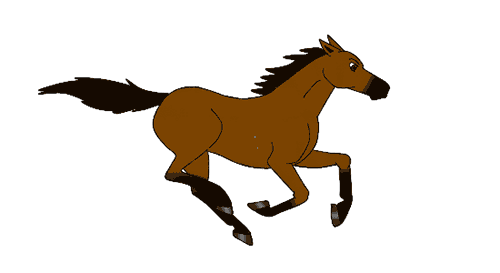

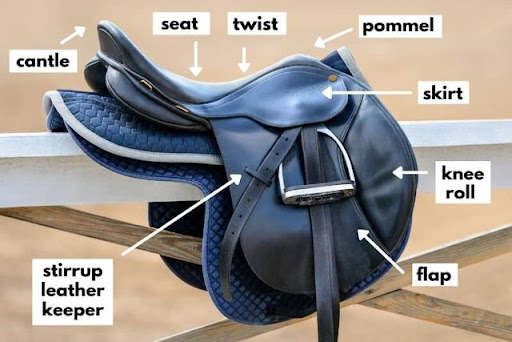
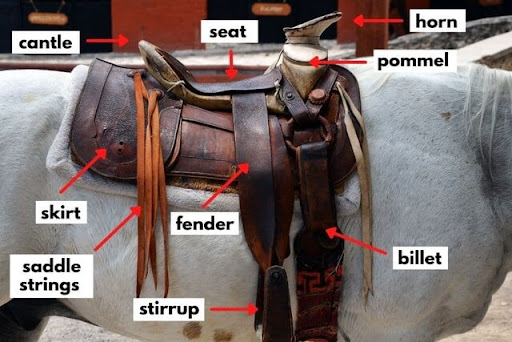
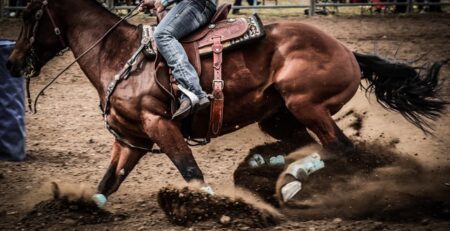
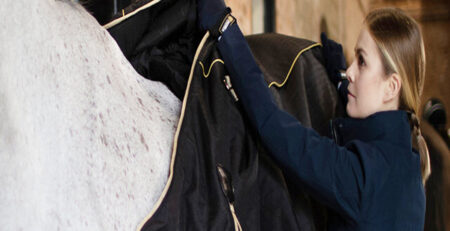
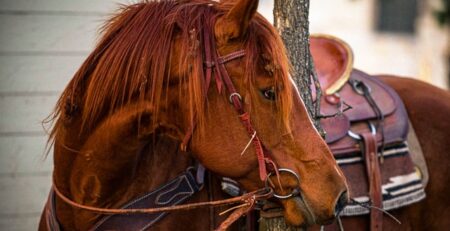
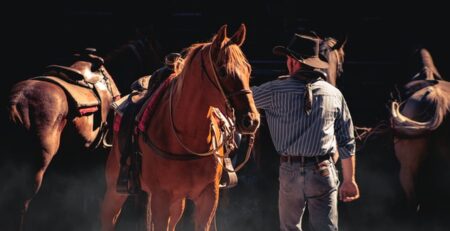
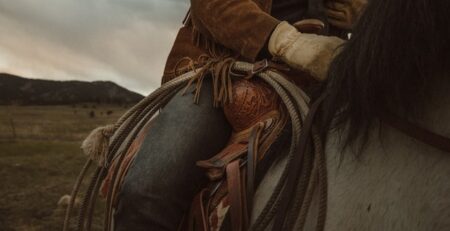
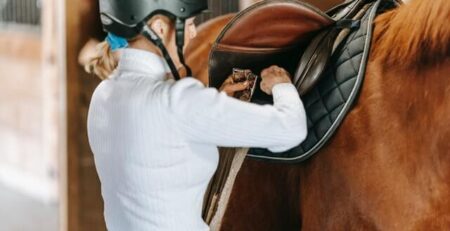
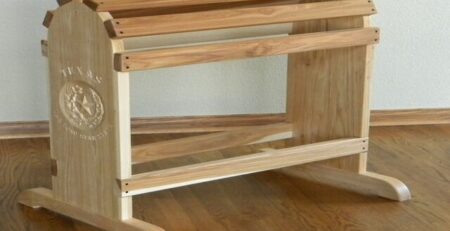

LEAVE A COMMENT